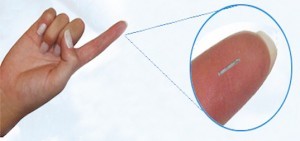 Sensors for Medicine and Science announced that its implanted continuous glucose sensor, which the company is currently developing, has demonstrated highly accurate results. The sensor tracked glucose levels in study participants with a 77.6% accuracy in the A zone of the Clark Error Grid and a 19.2% in the B zone of the grid, resulting in a mean absolute difference of 12.2%. It is the first time an implant-based sensor has achieved such accuracy. The study also achieved the goal of continuous sensor use in patients for over six months.
Sensors for Medicine and Science announced that its implanted continuous glucose sensor, which the company is currently developing, has demonstrated highly accurate results. The sensor tracked glucose levels in study participants with a 77.6% accuracy in the A zone of the Clark Error Grid and a 19.2% in the B zone of the grid, resulting in a mean absolute difference of 12.2%. It is the first time an implant-based sensor has achieved such accuracy. The study also achieved the goal of continuous sensor use in patients for over six months.
“We are pleased to report these findings as a first step to realizing a viable long-life implanted sensor to help millions of people with diabetes manage their glucose better,” Tim Goodnow, Ph.D., president and CEO of Sensors for Medicine and Science. “While still early, the pilot study showed comparable performance as current continuous glucose devices.”
The data gathered by the researchers will be presented in Lisbon, Portugal on September 16, 2011, at the meeting of the European Association for the Study of Diabetes.
The new system is comprised of a reader and a sensor, which is implanted in the subcutaneous area of the patient’s wrist. The sensor is powered by inductive currents and is remotely interrogated; it doesn’t require a battery to function and isn’t even wired to the reader, which is a wristwatch-like device that displays blood glucose levels. Once it is implanted, the sensor functions continuously and automatically.
The study involved nine subjects who had Type 1 diabetes. The participants were implanted with a sensor in each wrist for about 29 days; researchers analyzed about 3,000 results from the sensors and compared them with YSI blood glucose levels. Using the Clarke Error Grid, or CEG analysis, the researchers demonstrated that 96.8% of the readings fell into zones A or B of the grid, which is used to measure differences between lab references and glucose monitoring devices. The grid is divided into five zones, labeled A, B, C, D, and E. Results in zone A are considered very accurate while results in zone B are clinically acceptable; C, D, and E results are less accurate.
“Based on the promising results obtained, we plan to initiate more clinical trials in the very near future, including pursuing collaboration on artificial pancreas research,” says Goodnow.
Sensors for Medicine and Science is focused on developing chemical sensing technologies that help monitor the presence of important compounds in the body, such as glucose for diabetics. The sensor is smaller than a penny; it automatically measures glucose levels every few minutes without requiring any input from the patient and communicates the data wirelessly to the external wristwatch receiver. SMSI hopes that patients will use the device for 6-12 months, after which it will be replaced to ensure proper functioning.
One of the primary motivators for SMSI’s development of an automatic, non-invasive glucose monitoring solutions is the lack of proper monitoring in diabetics; the company cites that on average, diabetics check their blood sugar less than twice a day. According to SMSI, the pain and inconvenience of the finger prick test discourages diabetics from checking their blood glucose frequently; a non-invasive monitoring device would help diabetics monitor their blood glucose more closely.
Additionally, SMSI states that standard glucose measuring can be complex and cumbersome, often leading to patient error of up to 15-20% in actual blood glucose levels, partly from user error. An implanted glucose sensor would sidestep many of the complications that surround glucose monitoring today.